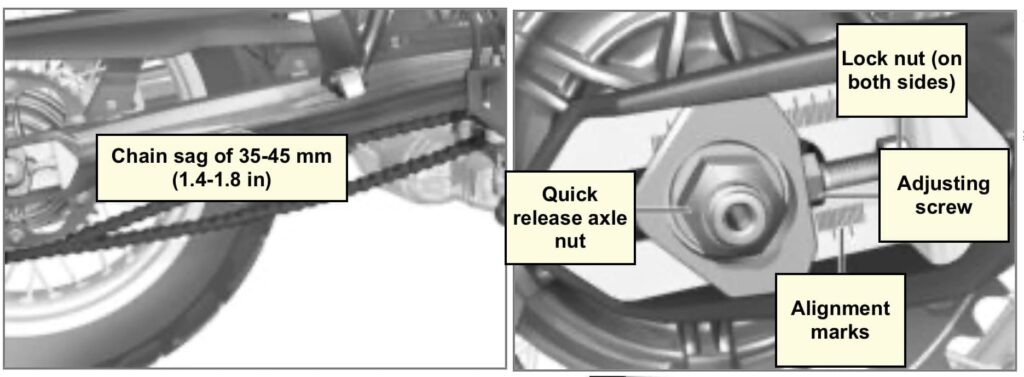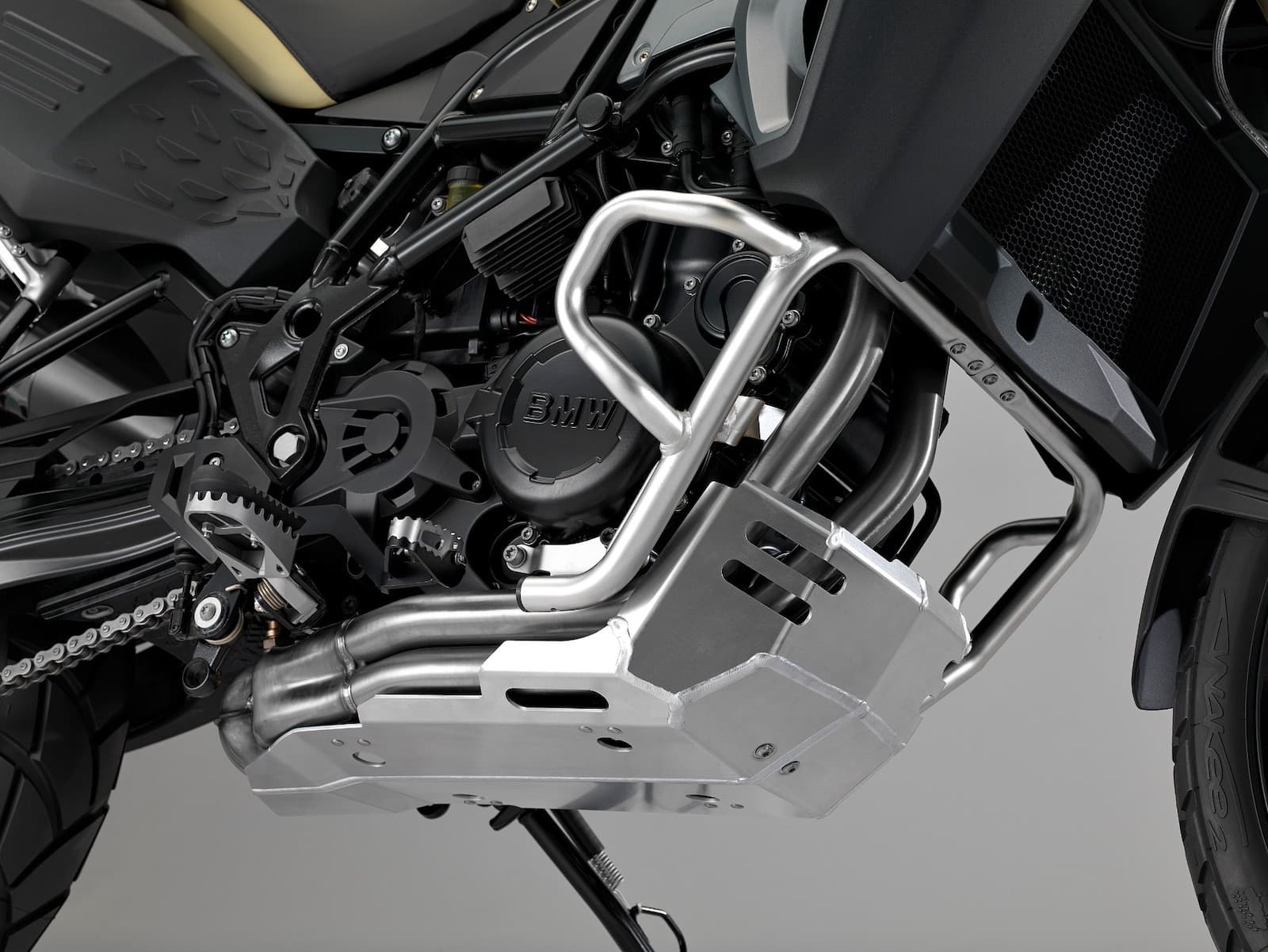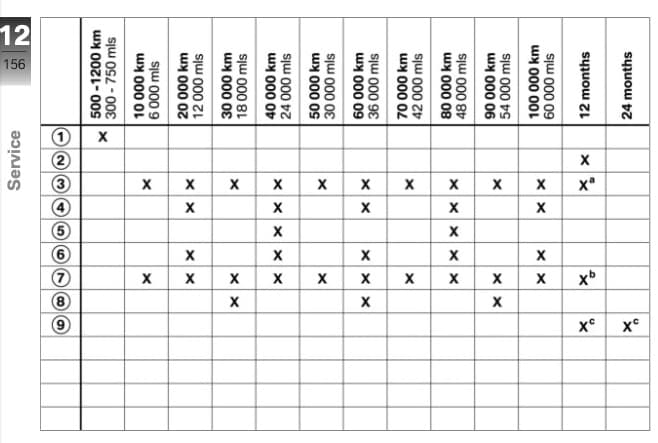BMW F 800 GS Adventure (2013-2018) Maintenance Schedule and Service Intervals
This is the maintenance schedule and service intervals for the BMW F 800 GS Adventure (sometimes called the GSA by its loyal fans), BMW’s middleweight adventure motorcycle, made from model years 2013 through to 2018.
The BMW F 800 GS was first announced in 2007 for the 2008 model year, when it was introduced along with the new F 650 GS (with the same capacity detuned parallel twin motor, and other lower specs).
The F 800 GS Adventure was released sometime later, in mid 2013. It’s powered by the same engine as in the base model F 800 GS — a 798cc four-valve-per-cylinder DOHC parallel twin engine that makes 63 kW (71 hp) @ 7000 rpm, and maximum torque of 75 Nm at 4500 rpm, relatively low. But the Adventure comes with more fuel tank capacity and other long-distance travel-ready features.
In 2016, BMW added ride by wire to both the base GS and GS Adventure, eliminating the throttle cable (which you previously had to keep lubricated), but the maintenance schedule otherwise stayed the same.
In 2018, BMW updated this model, replacing the F 800 GS Adventure with the F 850 GS Adventure for the 2019 model year.
This site has links for things like oil and spark plugs from which we earn a commission (which unfortunately nobody can save, not even us). If you appreciate this work, then please use those links. Thanks!
BMW F 800 GS Adventure Service Intervals
The BMW F 800 GS Adventure has 6000 mile / 10000 km or annual service intervals.
Every service, change the oil and filter. Annually, inspect a bunch of other items mentioned in the annual inspection checklist.
BMW recommends you replace the air filter and check the valve clearances every 12000 miles / 20000 km — a distance-based interval only.
As the F 800 GS has a liquid-cooled engine, you do have to check the coolant. But BMW doesn’t specify a coolant change interval.
What you need to service the BMW F 800 GS Adventure
Luckily, the parts needed to do a basic service on the BMW F 800 GS have remained the same across the years, as the engine wasn’t updated significantly from a maintenance perspective.
| Part | BMW F 800 GS Adventure part spec |
|---|---|
| Oil | BMW recommends using BMW Advantec Pro 15W-50, their own brand, but you can use other 15W-50 synthetic oils of high quality (API SJ/JASO MA2). |
| Oil filter | The standard oil filter is BMW part 11 42 8 409 567, which is equivalent to Hiflofiltro HF160RC. |
| Air filter | BMW part number 13 71 8 529 998, which is equivalent to Hiflofiltro HFA7913. |
| Spark plug | The standard spark plug is an NGK DCPR8E per the manual. BMW part number is 12 12 7 690 603. |
| Brake fluid | Use DOT 4 brake fluid, e.g. Castrol DOT 4, or you can get BMW part number 83 13 2 445 461 for the official stuff |
| Brake pads | Part numbers for the brake pads are 34 11 7 705 216 for the front brake pads (you need 2 pairs) and 34 21 7 722 884 for the rear. |
| Cable lubricant | Use Protect all cable life to lubricate moving cables. |
| General grease | Use a lithium soap-based grease for external pivot points like the kickstand etc. |
Maintenance schedule for the BMW F 800 GS Adventure
Below is the maintenance schedule for the BMW F 800 GS. It has been adapted to be a little easier to read and to fit this screen.
Notes on the schedule:
- Where there’s a time-based interval and a distance-based interval, do the earlier of the two. E.g. change the oil at 10000 km / every year, whichever comes earlier.
- To avoid repetition, the maintenance schedule is cut off at 40000 km / 24000 mi. Keep repeating the schedule every 1, 2, 3, or 4 service intervals.
- The break-in schedule is not shown as these bikes are no longer sold new.
| km x 1000 | 10 | 20 | 30 | 40 | |
|---|---|---|---|---|---|
| mi x 1000 | 6 | 12 | 18 | 24 | Every |
| Standard BMW service (see below) | Year | ||||
| Engine oil change with filter | X | X | X | X | Year |
| Check valve clearance | X | X | |||
| Replace all spark plugs | X | ||||
| Replace air cleaner insert | X | X | |||
| Check or replace the air filter element | X | X | X | X | When used off road, every year |
| Telescopic fork oil change | X | ||||
| Change brake fluid in entire system | 2 years |
Standard scope of service — BMW F 800 GS Adventure
The standard 10,000 km (6,000 mile) service list of items is below, referred to in the maintenance schedule as being the “Standard BMW service”.
Two notes:
- [D] means items that a dealer does.
- [CT] is for models with a cable throttle, before the Ride by Wire update in 2016. Other maintenance items are 100% identical.
| Standard scope of service — BMW F 800 GS Adventure |
|---|
| [D] Performing the brief test using the BMW Motorrad diagnostic system |
| Check coolant level |
| Check/adjust clutch play |
| [CT] Check accelerator Bowden cable for ease of movement, chafing and kinks, and play |
| Check the front/rear brake fluid level |
| Check the front/rear brake pads and brake discs for wear |
| Visually inspect the brake lines, brake hoses, and connections |
| Check tension of spokes and tighten as needed |
| Check the tire pressure and tread depth |
| Check and lubricate the chain drive |
| Check side stand for ease of movement |
| Check centre stand for ease of movement (when fitted) |
| Check the lighting and signal system |
| Check the steering-head bearing |
| Check the engine start suppression works |
| Final inspection and road safety check |
| [D] Set the service date and remaining distance to service |
| Check charging state of battery |
| [D] Confirm the BMW service in the vehicle literature |
BMW F 800 GS / Adventure Chain Maintenance
As the BMW F 800 GS has a chain final drive, it’s important to regularly lubricate and clean the chain. Use a good-quality lubricant, like Motul chain lubricant, or Motul chain paste, a popular affordable and portable lube.
At every service, check the chain condition and chain sag. If necessary, adjust the chain sag.

To check the chain sag, follow these steps:
- Put the motorcycle onto its kickstand on a level surface. Make sure it’s in neutral.
- Moe the motorcycle around until you find the point with the maximum sag (where the chain is lowest).
- Use a steel ruler and a rag or screwdriver to push the chain up and measure the total deflection.
Target deflection for the BMW F 800 GS: 35-45 mm (1.4-1.8 in). If the chain is out of spec, you have to adjust the sag.
To adjust the sag, follow these steps.
- Loosen the axle nut.
- Loosen the lock nuts
- Turn the adjusting screws on the left and right to adjust sag. Check the alignment marks on both sides to make sure the chain is still aligned.
- Keep checking sag.
- Tighten the locknuts to 19 Nm / 14 lb-ft
- Tighten the axle nut to 100 Nm / 74 lb-ft.
Wheels and Tires on the BMW F 800 GS Adventure
The BMW F 800 GS Adventure ships standard with the following tire sizes and pressures.
| Wheel | Tyre size | Tyre pressure (cold) |
|---|---|---|
| Front | 90/90-21 | 2.2-2.5 bar (one-up to 2-up/with luggage) |
| Rear | 150/70-17 | 2.5-2.9 bar (one-up to 2-up/with luggage) |
About the BMW F 800 GS Adventure

BMW announced the F 800 GS Adventure in May 2013 as an all-new model, based on the existing F 800 GS. The F 800 GS Adventure is BMW’s middleweight adventure motorcycle.
The base model F 800 GS already had off-road adventure orientation — it had a 21-inch tyre and long-travel suspension.
But the F 800 GS Adventure built further upon this, by adding the following long-range features:
- Larger 24 litre fuel tank (50% larger), extending range by approximately 120 km/75 miles
- Standard ABS
- New, adventure-styled bodywork
- A larger windscreen
- Enduro footrests
- Reinforced rear subframe
- An adjustable, reinforced foot brake lever
- An engine protection bar
- Pannier rack which functions as a tank protection bar
BMW used the same 798cc dual overhead-cam liquid-cooled parallel twin for the F 800 GSA as in the F 800 GS. It’s a torque-forward 360-degree parallel twin that makes a peak of 63 kW (85 hp) @ 7,500 rpm, with torque peaking a little lower at 5,750 rpm.
An unusual characteristic of the F 800 GS’ parallel twin engine is the firing order. It has a 360-degree crank, which means one firing cycle for each crankshaft rotation. The pistons move up and down together. This means the sound is just like that of boxer engines (i.e. the bigger GSA brethren), which have the same firing offset.
However, unlike the bigger boxers, the F 800 GS and F 800 GSA don’t have that “kick over to the side” feeling you get when you crack the throttle.
The pistons moving together leads to some vibration, which is smoothed out using a balance shaft. Despite this, the F 800 GS is still a vibey-bike, but so are all BMW adventure bikes.
BMW claims the 360-degree crank gives the engine unique torque characteristics, but the later F 850 GS also has unique torque characteristics with its 270-degree crank.
As you’d expect from an adventure bike, the BMW F 800 GS Adventure has ample suspension travel. The front forks (which are conventional forks, not Telelever like on the R 1200 GS) give you 230mm of travel.
The first BMW F 800 GS Adventure uses the updated parallel twin that the F 800 GS received in 2013.
In 2017, BMW updated the engine again, adding ride-by-wire with ride modes. However, aside from lacking a throttle cable, there was no impact on the maintenance schedule.
After 2018, BMW retired the F 800 GS Adventure in favour of the F 850 GS Adventure.

Manual for the BMW F 800 GS Adventure
The maintenance schedule for the BMW F 800 GS Adventure came from the user’s manual. We used a few from different years and compared them. You can see screenshots below.
You can download the user manuals directly from BMW’s website here.
















